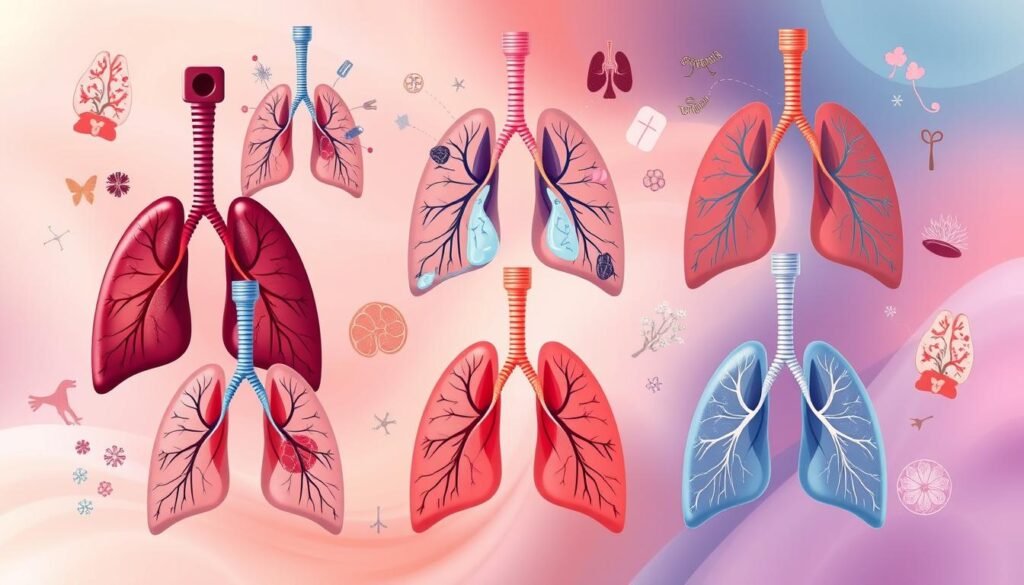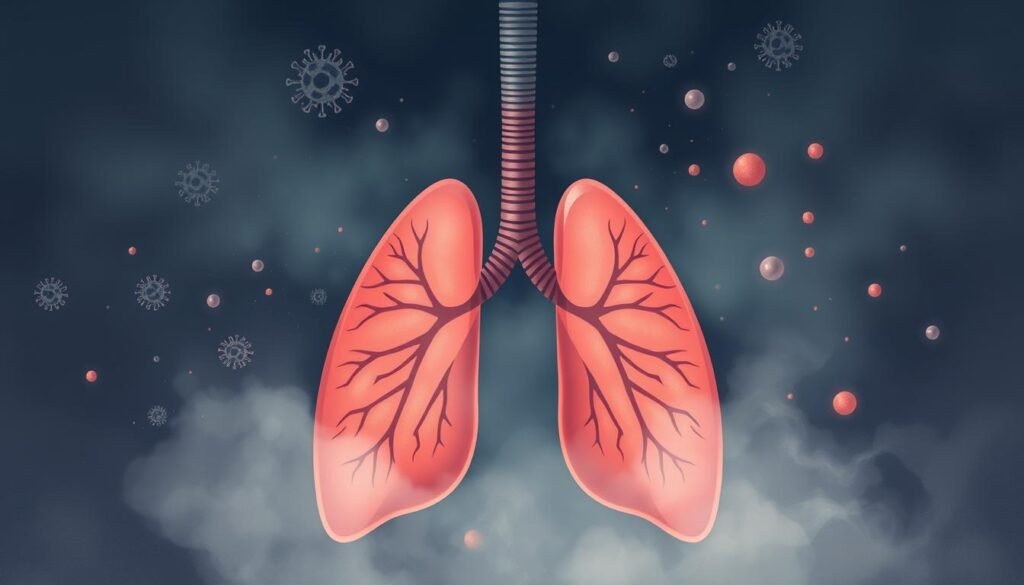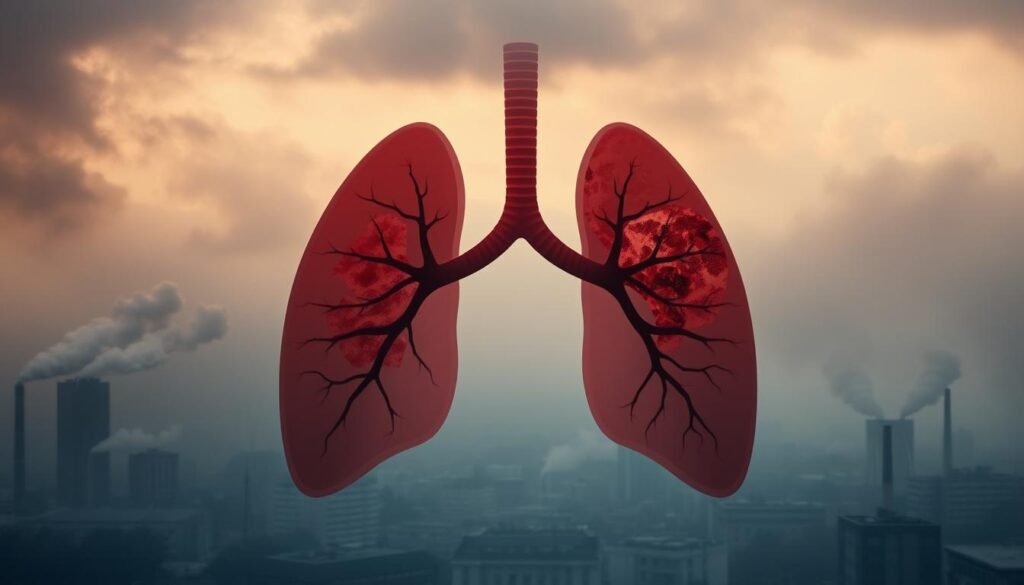In 2017, around 544.9 million people all over the globe had a chronic respiratory disease. This was a huge 39.8% increase from 1990. Conditions like asthma and Chronic Obstructive Pulmonary Disease (COPD) are big concerns for public health. They are top risk factors for other health problems.
Not only do these diseases cause a lot of deaths, making them the third leading cause of death with nearly 3.9 million deaths in 2017, but they also bring high healthcare costs and lower the quality of life. It’s crucial to explore how chronic respiratory conditions affect lung health. This helps in finding better ways to manage and prevent them. Spotting the early signs is key, especially since patients with COPD are more likely to get lung cancer. A late diagnosis is too common and can complicate treatment.
Key Takeaways
- Over 544 million people are affected by chronic respiratory diseases worldwide.
- Chronic respiratory conditions are a leading cause of mortality, with millions of deaths recorded annually.
- COPD patients face heightened risks for other serious conditions like lung cancer.
- Understanding the symptoms and differences between conditions is essential for timely treatment.
- Environmental factors, such as air quality and smoking, greatly influence lung health.
Understanding Chronic Respiratory Conditions
Chronic respiratory conditions are serious health problems. They include issues like asthma, COPD, and other diseases that really affect our lungs. Knowing about these helps us tackle their impacts on public health better.
Definition and Importance of Chronic Respiratory Conditions
Chronic respiratory conditions are diseases that harm the airways and lungs for a long time. They are common among all ages and pose big challenges globally. Managing them is crucial as they lead to more sickness and deaths. Asthma, for example, affects about 25 million people in the U.S., making it a very common chronic disease among kids and adults.
Prevalence and Impact on Public Health
A lot of people have respiratory diseases, with over 64 million dealing with COPD worldwide. In the U.S., 5 to 10 percent of adults have it, but more than half are not diagnosed. This underdiagnosis leads to a huge impact on public health, including about 700,000 hospital visits and over 137,000 deaths from COPD in the U.S. in 2009.
These chronic diseases also cost a lot of money. For example, the costs related to COPD reached about 32.1 billion dollars in 2002. These numbers show the economic strain of respiratory diseases on health systems. It points out the need for more awareness and public health actions. Learning more about allergic inflammation and its link to these conditions can improve lung health. You can find more information here.
| Condition | Estimated Number Affected | Annual Deaths | Healthcare Costs (Billions) |
|---|---|---|---|
| Asthma | 25 million (U.S.) | 4,100 | N/A |
| COPD | 64 million (globally) | 137,000 (U.S. 2009) | 32.1 |
| Other Chronic Lung Diseases | Varies | 150,000 (U.S. 2020) | N/A |
Common Types of Chronic Respiratory Conditions
Chronic respiratory conditions affect lung health. It’s crucial to know about these diseases for the right treatment. We will look into asthma, chronic obstructive pulmonary disease (COPD), and other conditions that affect millions.
A Brief Overview of Asthma
Asthma is an ongoing inflammation of the airways. It causes wheezing, breathlessness, chest tightness, and coughing. In 2019, around 262 million people worldwide had asthma, which can lead to serious health issues without good asthma management. People of all ages should use medication and change their lifestyle to control their symptoms.
Chronic Obstructive Pulmonary Disease (COPD) Explained
COPD includes bronchitis and emphysema. By 2020, about 480 million people were diagnosed, making it a leading cause of death. Main COPD causes are long exposure to pollutants, especially cigarette smoke. COPD symptoms are continuous cough, mucus, and breathing trouble. Understanding COPD is key to manage and slow down its progression.
Other Conditions: Emphysema, Bronchitis, and Pulmonary Fibrosis
Emphysema and bronchitis are part of COPD. They’re important for lung health. Emphysema destroys lung air sacs, affecting gas exchange. Bronchitis means the bronchial tubes are inflamed. Pulmonary fibrosis scars the lungs, hurting lung function. Recognizing these symptoms and getting medical help is vital.

| Condition | Common Symptoms | Global Prevalence | Main Risk Factors |
|---|---|---|---|
| Asthma | Wheezing, breathlessness, chest tightness, coughing | 262 million (2019) | Allergies, environmental factors |
| COPD | Cough, mucus production, difficulty breathing | 480 million (2020) | Smoking, air pollution, occupational exposure |
| Emphysema | Shortness of breath, chronic cough | Part of COPD prevalence | Smoking, genetic factors |
| Bronchitis | Persistent cough, production of mucus | Part of COPD prevalence | Smoking, infections, air pollutants |
| Pulmonary Fibrosis | Shortness of breath, dry cough | 2.28 million (2019) | Environmental toxins, certain medications |
Chronic Respiratory Conditions as Risk Factors
Chronic respiratory conditions are big risk factors for many health issues. They often link with other chronic diseases. Understanding this connection helps manage health better.
Connection to Other Health Issues
The interaction between chronic respiratory problems and other health issues complicates treatment. Many people with respiratory conditions also have diseases like heart disease, diabetes, and lung cancer. This relationship makes health worse and increases the risk of infections and problems.
It’s important to take care of these patients in a way that addresses all their health issues at once.
How Chronic Respiratory Conditions Increase Overall Health Risks
Chronic respiratory conditions make health risks much higher. This leads to more hospital visits and deaths. In 2019, respiratory diseases caused about 4 million deaths worldwide.
Hospital data shows that people with severe respiratory conditions have a higher chance of bad outcomes. The hospitalization rate for those 65 and older with COPD was 82.92 per 1,000 Medicare enrollees. There’s a big need for health strategies focused on managing these diseases and lowering health risks.

| Health Issues | Associated Chronic Respiratory Conditions | Prevalence Metric |
|---|---|---|
| Cardiovascular Diseases | Chronic Obstructive Pulmonary Disease (COPD) | 3.3 million deaths globally (2019) |
| Diabetes | Asthma | 262.4 million cases globally (2019) |
| Lung Cancer | Emphysema, Bronchitis, Pulmonary Fibrosis | 454.6 million prevalent cases globally (2019) |
The Role of Environmental Factors
Environmental factors greatly impact chronic respiratory problems, especially in vulnerable groups. Knowing how these factors affect lung health is key to tackling public health issues.
Air Pollution Exposure and Lung Health
Air pollution is a critical risk for respiratory diseases. Particulate matter (PM 2.5) and nitrogen oxides are well-studied pollutants. They are linked to worsened lung health and more cases of asthma and COPD. Studies show that pollution increases hospital and emergency visits, especially when pollen levels are high.

Importance of Clean Air Initiatives
Clean air initiatives are key in fighting air pollution effects. Public health policies aimed at improving air quality are crucial. They lower respiratory illness rates. Plans for tighter air quality controls and boosting community knowledge help reduce pollutant exposure. Supporting these efforts protects vulnerable groups, like children and those with existing health issues. Pushing for cleaner air policies leads us towards healthier communities.
| Environmental Risk Factors | Lung Health Effects | Public Health Interventions |
|---|---|---|
| Air pollution exposure | Increased asthma attacks and COPD exacerbations | Implementation of clean air initiatives |
| Indoor mold exposure | Worsening of asthma and rhinitis | Public awareness programs |
| Forest fires | Elevation in respiratory illnesses | Emergency response strategies |
| Climate change impacts | Prolonged pollen seasons | Adaptation policies for at-risk populations |
Smoking History and Its Link to Chronic Respiratory Conditions
Tobacco use can seriously harm your lungs and overall health. Many smokers don’t fully grasp how tobacco smoke effects lung tissue. This can lead to serious breathing problems. Learning about smoking’s role in chronic lung diseases can help people see the benefits of quitting.
Effects of Tobacco Smoke on Lung Function
When you inhale tobacco smoke, you’re bringing in harmful stuff like nitrogen dioxide and carbon monoxide. Studies show these can make lung function worse, leading to long-term damage. Imagine someone smoking 40 packs a year. They’d inhale smoke from about 290,000 cigarettes, raising their risk of getting Chronic Obstructive Pulmonary Disease (COPD). Smoking is blamed for around 90,582 COPD deaths each year.
Cigarette smoke has many toxins and cancer-causing chemicals. These harm your lungs’ delicate parts. If you keep smoking, it causes constant inflammation and makes your lungs prone to infections. This means your body’s natural defenses are weakened, putting your health at even greater risk.
The Significance of Quitting Smoking
Quitting smoking can do wonders for your lung health and lower disease risk. Stopping can actually let your body start to heal. You’ll face a lower risk of lung cancer, have a smaller chance of getting COPD, and breathe better overall.
Joining smoking cessation programs can really help if you’re trying to quit. These programs offer counseling, tips on changing your behavior, and quit aids like nicotine patches and gum. These resources boost your odds of quitting for good, letting you enjoy a healthier life.
Respiratory Infections: A Contributing Factor
Respiratory infections are a big problem for people with chronic lung diseases. These diseases can make symptoms worse and lead to more hospital stays. It’s especially true for those with asthma and COPD. Understanding how infections affect chronic diseases is key to helping patients.
Impact of Respiratory Infections on Patients with Chronic Conditions
Respiratory infections can make chronic lung diseases like asthma and COPD worse. This can lead to serious problems and might require doctors’ help. People with these conditions are at greater risk when they get infections. Their symptoms get worse, affecting their life and increasing medical costs.
Vaccination and Preventive Measures
Vaccines play a big role in preventing infections for people with chronic diseases. Staying up to date with flu and pneumonia shots is very important. These vaccines greatly reduce the risk of getting sick. Seeing vaccination as a key part of managing chronic diseases is critical.
It’s important to educate people on why vaccines are necessary. They help a lot in preventing illnesses, which is good for overall health.
| Infection | Effect on Chronic Disease | Preventive Measures |
|---|---|---|
| Flu | Can cause severe asthma attacks | Annual flu vaccination |
| Pneumonia | Leading cause of hospitalizations | Pneumonia vaccination every 5-10 years |
| Common Cold | Exacerbates COPD symptoms | Good hygiene practices |
| COVID-19 | Heightens risks and complications | COVID-19 vaccination and boosters |
Understanding the value of prevention, including vaccines, is vital for people with chronic lung diseases. Being proactive about health can lead to better outcomes and a happier life.
To learn more about what causes asthma and other respiratory conditions, check out this link.
Age and Gender Considerations in Respiratory Health
As people grow older, their lung function changes. This lung function decline is part of how aging affects lung health. It leads to a greater risk of chronic respiratory diseases. Thus, it’s important to focus on these issues as our population gets older.
Aging and Lung Function Decline
Aging makes people more prone to respiratory problems like Chronic Obstructive Pulmonary Disease (COPD). Older individuals often see their lung function get worse. This can impact their health significantly. Many people over 65 suffer from respiratory conditions. Therefore, special healthcare practices are needed to help them.
Gender-Specific Risk Factors and Outcomes
Men and women face different risks when it comes to respiratory diseases. For example, women make up over half of COPD-related deaths in 2009, about 53%. They are 37% more likely to get COPD than men. This is after considering smoking habits and social status. Women also tend to have chronic bronchitis more than emphysema, unlike men.
Gender also affects how quickly lung function declines. Women who smoke may see faster declines in lung function. This could be due to how their bodies respond to tobacco. Moreover, women’s lungs have unique features. For instance, they experience a slower rate of telomere shortening. This affects how aging impacts their lung health.
It’s crucial to understand the different risks for men and women. This helps in creating better prevention strategies. As smoking habits change worldwide, especially among women, we need more research. This will help us recognize and meet the specific respiratory health needs of both genders.
Management and Prevention Strategies
To manage chronic respiratory issues well, combining management strategies, treatments, and lifestyle changes is key. It helps improve life quality for those affected.
Best Practices for Managing Chronic Respiratory Conditions
For better respiratory health, patients should follow recommended best practices. This includes properly using inhalers and avoiding triggers. Patients should also take part in pulmonary rehab programs and monitor their lung functions regularly. Staying updated on new treatments is also vital.
Preventive Measures for At-Risk Individuals
Preventive strategies are crucial to protect people at risk of chronic respiratory issues. Important steps include routine screenings and embracing lifestyle changes that include exercise and healthy eating. Learning about environmental risks is vital too. Vaccinations against respiratory infections are also recommended to safeguard those with current issues.
Conclusion
Chronic respiratory problems are a major health risk, causing many complications. They include diseases like COPD, asthma, and pulmonary hypertension. These are some of the top reasons for disability and early death around the world. Yet, they get little funding for research, only receiving 2% of grants for lung diseases. This shows we urgently need to pay more attention and provide more resources for better respiratory health.
When looking at chronic respiratory diseases, environment and work exposures are key. Smoking, air pollution, and indoor biomass burning make these diseases worse. So, dealing with them needs prevention, early detection, and the right treatments. This is especially true in countries with less money, where these diseases hit harder.
To handle this situation, we must educate the public, work towards cleaner air, and increase research funding for lung health. By doing so, we can improve people’s health and make our communities healthier. This will lead to big improvements in public health, benefitting everyone.